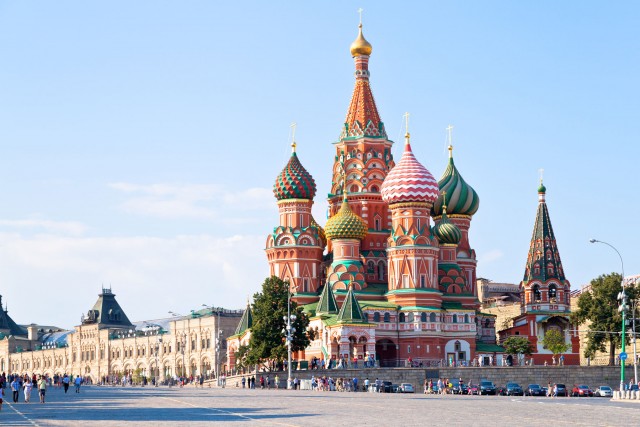Moscow
MOSCOW IS THE capital city of the Russian Federation, and although superseded as the official capital during the 18th and 19th centuries, it has dominated Russian politics, culture, and economics since the 14th century. Today, it is RUSSIA's largest city and one of the largest urban centers in Europe.
Geographically, Moscow lies at the center of European Russia, the center of the East European Plain. It lies on both sides of the Moscow River, a tributary of the much larger VOLGA, a short distance to the east. The Moscow Region is slightly hilly, wooded STEPPE. The climate is cool: Moderate temperatures in the short summer and bitterly cold in the long, dark winter, when temperatures generally are in the mid-teens F (-8 or -9 degrees C), but occasionally as low as -44 degrees F (-42 degrees C). The city itself is roughly circular, having been built in concentric waves out from the Kremlin, the city's physical and administrative heart. Most major roads in Moscow either circle or radiate from the Kremlin.

The city's boundary corresponds to the outer ring road situated 10 to 13 mi (17 to 21 km) from the city center, encompassing roughly 350 square mi (900 square km). Much of Russia's highway and railroad network radiate from this central point for thousands of miles in every direction. Since the 1930s, Moscow has been a port as well, with the Moscow Canal linking the city to the Volga and its vast internal waterway network connecting the BLACK SEA to the Baltic. Even during the period when Russia's Imperial capital was in SAINT PETERSBURG (1712–1918), Moscow's location at the center of the empire led to its development as Russia's center for industry, as well as a focus for the nation's emerging scientific and artistic communities. Today, Moscow is home to the Academy of Science and numerous colleges and universities, Russia's two main newspapers, and some of the most famous theaters and art galleries in the world, including the Bolshoi Theatre and the Tretiakov Gallery.
Moscow appeared first as a small village in the mid-12th century, strategically located at the center of TRADE ROUTES between the Volga River system and the rivers of the south and west. In 1156, a Russian prince, Yury Dolgoruky, built a wooden fortress on the north bank of the Moscow River, the first Kremlin, which became the center of the medieval city and eventually of an independent principality, called Muscovy. The princes of Muscovy became rich and powerful during Russia's dark period of Mongol occupation, due to the fact that they were employed by their Mongol overlords as tax collectors. Eventually, the princes became strong enough to overthrow the Mongols and to unify the other Russian principalities into one state. The Kremlin was rebuilt in the early 15th century, and it remains one of the greatest monuments to native Russian architectural styles, notably in the many churches and monasteries contained within its walls: the churches of the Assumption, Annunciation and the Archangel Michael. Prince Ivan “the Terrible,” completed the task of unifying Russia and in 1547 assumed a new title, tzar, reflecting his claims to imperial status and his conceptualization of Moscow as the “Third Rome,” spiritual heir to the fallen empire of Constantinople.
The capital was moved from Moscow to Saint Petersburg by Peter the Great in 1712, as part of Peter's efforts to bring Russia closer to the West and wider European culture. Over the next two centuries, Saint Petersburg and Moscow competed for position as Russia's major city, with Moscow frequently advocating conservative, traditional Russian and Orthodox culture, while aristocratic Saint Petersburg focusing on becoming as Western as possible. Saint Petersburg was considered Russia's head, but Moscow remained its heart. Much of the city was burned in 1812 by its own citizens, successfully forcing Napoleon's French troops to evacuate the region, a moment heroically immortalized in Peter Tchaikovsky's “1812 Overture.”
MODERN MOSCOW
Much of the architecture of the city reflects the rebuilding of the city in the following decades. The palaces in the Kremlin were rebuilt, including the Great Palace and the Palace of Congresses which today house the major government organs of the Russian state. Large squares replaced narrow streets and rickety wooden buildings, most notably Red Square along the east side of the Kremlin, the site of parades and ceremony to this day. After the revolutions of 1917, Vladimir Lenin recognized the value of Moscow's central location, as well as its defensibility from foreign invasion, and moved the capital back to Moscow. It became the capital of the Union of Soviet Socialist Republics officially in 1922.
Growth of railway lines and heavy industry was sped up, and millions of peasants, now landless and homeless, flocked to Moscow to find work. During the 1920s, the percentage of working-class residents living with the city's Garden Ring (the central region) increased from 5 percent to 45 percent. Cramped living conditions were finally tackled in massive building campaigns in the 1960s, resulting in today's huge apartment complexes around the city's edges, many built too fast and of inferior quality. Other buildings included monumental Soviet architecture, including Josef Stalin's infamous “seven sisters” skyscrapers.
Today, more than 8 million people live in Moscow, 11 million including its suburbs. In the past decade, large numbers of non-Russians have moved to the city, including Tatars, Chechens, and other peoples from the Caucasus. Moscow's speedy industrialization of the mid-20th century has left behind numerous air- and water-pollution problems. Moscow is a city of great contrasts, between ancient monasteries and ultra-modern office buildings, New Russian millionaires and poverty-stricken communist pensioners.